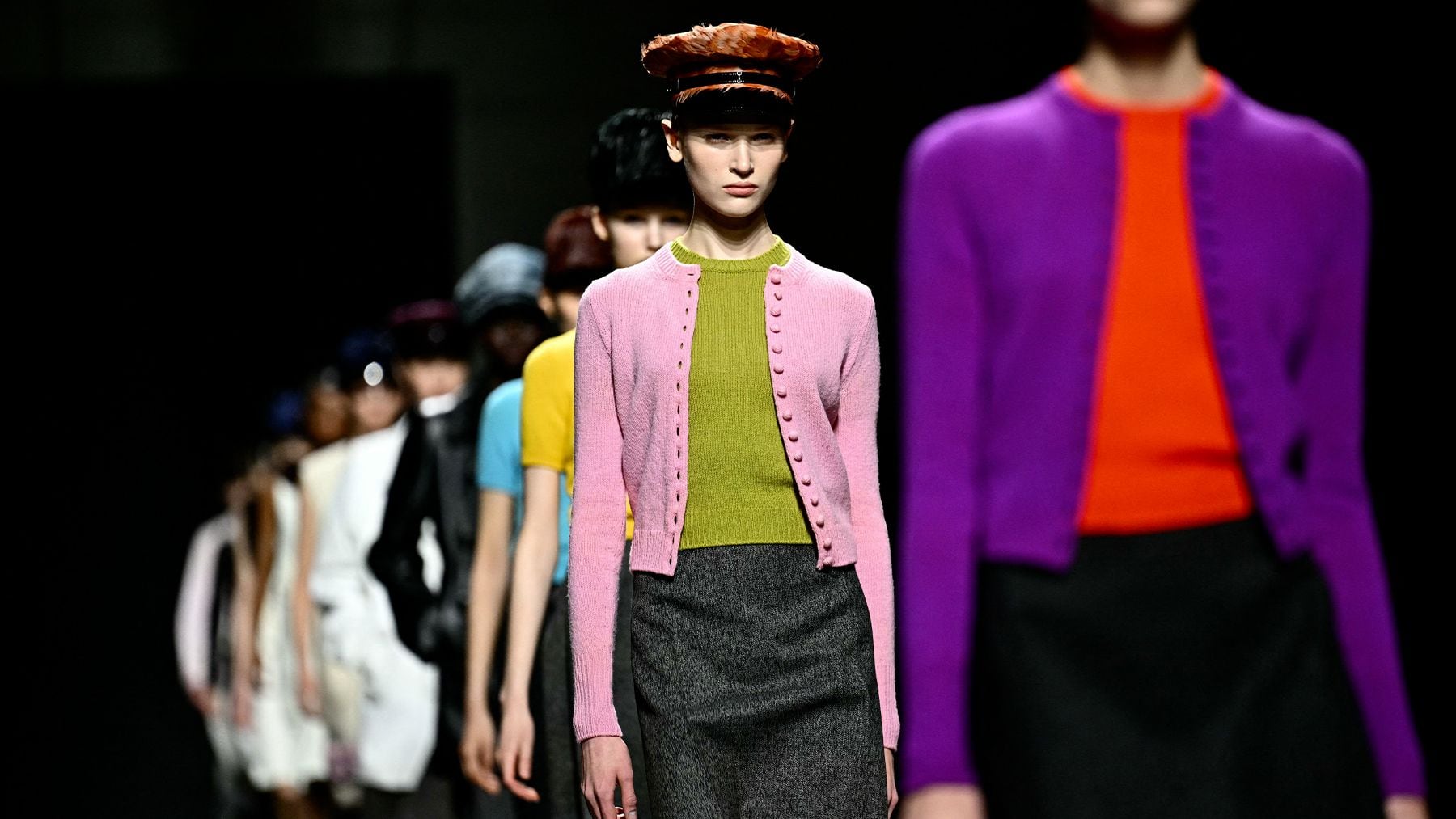
MILAN â The mood was sombre at Milan Fashion Week. Itâs perhaps understandable. Todayâs world is a dark place. Are clothes even relevant in such a climate? Of course, they are. Fashion comes with the promise of renewal and, as such, can offer comfort. Will people buy crazy designs at present? Probably not. At least, thatâs what most designers seem to think: everyone is scared, so better play it safe.
This was a bourgeois, bon ton season but it came with moody undertones. The mix worked particularly well at Bally, which Simone Bellotti, in the space of two seasons, has turned into a label to keep an eye on. By blending severe yet soulful tailoring â complete with pleasant Romeo Gigli innuendos â and wild touches such as hairy sheepskin backs on jackets and studs on vests, Bellotti delivered a desirable mix of control and abandon, complete with classic but subtly deranged accessories.
At Fendi, a similar mix looked contrived and frumpy â bodysuits left undone anyone? Despite claiming inspiration from Silvia Venturini Fendiâs own personal style, the collection shown by artistic director Kim Jones read as out of sync with the Roman exuberance that is key to the brand.
Dark hues do not need to feel bleak. Giorgio Armani made a convincing case that women look wonderful in black. This season felt particularly soft and gentle, with flower motifs lending a pictorial touch to timeless, liquid lines. The mixed blues and blacks that won over the trademark camels at Max Mara were elegantly elongated: a feat of ease that speaks to what busy women really want to wear.
At Etro, where colour and print usually reign, the sight of black might have made die-hard fans gasp, but Marco De Vincenzo managed to make black, mixed with earthy hues, feel lively and layered. This was a standout show for the house: we could finally see De Vincenzo let go and do Etro his own way while still being respectful of the brandâs DNA. The layering of elements â and that included trademark paisley, done in knitwear â was rich, while the peeling yet controlled shapes had a charm of their own.
The mood for severity, stripping down excess while opting for a soft edge was pervasive this week. Even Donatella Versace was so inclined, delivering a forceful Princess TNT fantasy of punk meets upper class that a tighter edit would have made even punchier. Dolce & Gabbana hammered black-tie seduction and transparency, and it was sharp. At Roberto Cavalli, Fausto Puglisi worked on forgiving shapes and a gentle attitude, but the heaviness of the marble prints was stuck somewhere between monumental and suffocating.
Daniel Del Core was again focused on mutations, but the clothes, in particular the wrapped capes and the textured knits, had a new, streamlined appeal that felt fresh: a very interesting direction to pursue for the house. Over at MSGM, in an attempt to move the label upward and onwards, Massimo Giorgetti explored a kind of uptown poshness with a slightly rebellious attitude. The concise edit was commendable, but not all of it worked. Marco Rambaldi, too, charted more conservative waters and took a step forward. Lorenzo Serafini did minimal with a Basic Instinct-meets-Alfred Hitchcock tingle. It came with too many nods to early Jil Sander, but also a fresh take on colour.
Elsewhere, Matteo Tamburiniâs debut at Todâs bore clear signs of his long tenure at Bottega Veneta: the beautifully crafted trench coats, the imposing bags and the general sense of monumental stiffness seemed to come from there, although done with a lighter, charmingly Italian hand and a chic subtleness. Of course, this was a debut collection, put together in a short time, and it needs to be evaluated as such. The potential is there.
At Bottega Veneta itself, Matthieu Blazy, in talking about his silhouettes, used the definition âmonoliths in the darkâ which felt particularly apt. One cannot but admire the level of craft, and of invention, that Blazy puts into his extensive collections. This latest outing was particularly strong on sturdy outerwear, draped dressing and daywear stripped bare of decoration, but it also felt like Blazy was trying too hard.
At Ferragamo, Maximilian Davis was also trying too hard, working with 1920s references while juxtaposing protective outerwear with slinky and flimsy dresses. On a positive note, the collection exuded a newfound sensuality, but it also had too many late-90s Prada references and oozed a slightly sinister militaristic vibe that felt more than a little unsettling.
Over at Jil Sander, it was the 1920s again, complete with fringed headgear and elongation. But the hand felt a bit heavy, and the pureness of the beautiful design got lost in the layering. As a side note, at Jil, just like at Ferragamo and elsewhere, there were Swiffer-like feathered shoes, which seems to be the bold footwear of choice of the season (credit to Marco Zanini, who did them first at Rochas in 2013).
This was a season of debuts and sophomore shows, and with that, hopefully, of new points of view on known brands. At Moschino, Adrian Appiolaza, who only arrived in January, delved deep into the archive of founder Franco Moschino to move out of the cartoon quicksands where the label got stuck under Jeremy Scott. In doing so, he dug out many items as they were, going for a Margiela-like exact replica of the existing. Appiolaza is a dedicated fashion archiver, so the approach makes sense, even though it felt a bit nostalgic. There was an elegance to it all that was fresh, and many covetable pieces that will attract new customers, but in future outings, it will be interesting to see more of Adrian and less of Franco.
Over at Blumarine, Walter Chiapponi traded the Y2K brashness of predecessor Nicola Brognano for seedy, gritty romanticism: coats and knickers, think Hole-era Courtney Love, circa 1994, but make it Berlin Zoo with a bit of Nan Goldin or Corinne Day in the mix. It was an interesting move and a touching debut, one that also came with some charming replicas from the archive, and that felt replete with melancholia on top of an early Alessandro Michele at Gucci vibe.
Speaking of which, a clear point of view is still missing at Gucci. This was Sabato De Sarnoâs second womenswear show for the house, and still one struggles to see what his vision is about. Heâs no storyteller, which is fine, but creative direction is more than just putting product on the catwalk.
At Tom Ford, Peter Hawkings was again overzealous with the codes that Tom built, and the resulting collection was faultless but déjà vu. Over at Diesel, Glenn Martens is the one who is making it all work in the punchiest of ways. His approach to denim, slinky dresses and a sleazy street-worthy wardrobe is remarkable. Martens has succeeded in restoring Dieselâs cool factor.
At Ferrari, Rocco Iannone is focused on the engineering of shapes, which is a fine idea, but one that requires lots of effort in the atelier. At the moment, itâs still not convincing. Filippo Grazioli focused on stripes at Missoni, starting where Rosita and Ottavio began: five striped dresses in 1958. The collection ranged from graphic to sculptural but was strongest when Grazioli kept things simple.
One wishes that the fashion flock would take greater notice of Loris Messina and Simone Rizzo of Sunnei, who are ready to take a creative directorship should someone offer. Their vision, expressed in another amusing show in which the soundtrack was composed of the thoughts of the models, is fully formed; their take on playfulness mature and personal.
Daniele Calcaterra, too, is a hidden gem: a designer of volumes and textures with a wonderfully poetic approach. And Alessandro DelâAcqua keeps staying in his niche delivering the goods. Certainly, his work owes a debt to Miuccia Prada, but there is a vision to what heâs doing at N.21 thatâs all his own. This season he was in particularly good form, scissoring bon ton tropes with unremitting fury to create a slashed take on couture thar felt relevant and directional.
Ultimately, what really stood out most in Milan was the act of scissoring: the collections that mattered were all about the radicality of cut. The back of jackets, coats and skirts were scissored away at Prada. As much as it felt counterintuitive in commercial terms, it gave movement and grace to the elongated silhouettes, owing much to Roberto Capucciâs linea scatola. But the results felt unresolved, a bit over-styled and, at times, scholastic.
It was Francesco Risso at Marni who really stole the scene. Beyond the crazy artist persona he has fashioned for himself, Risso is capable of some truly radical blows. This season he stripped everything down to a raw elementality that felt full of primeval power: a graphic, instinctual reset that was probably more a statement of image than a commercial proposition, but as a message it pleased both the eyes and the mind.



